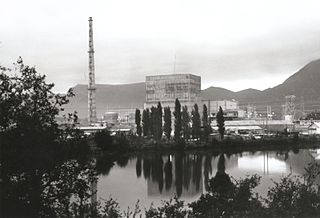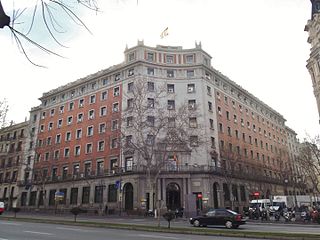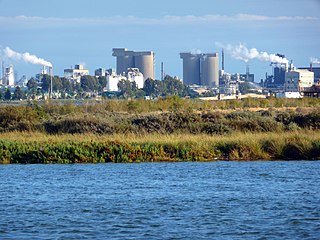Related Research Articles

The International Atomic Energy Agency (IAEA) is an intergovernmental organization that seeks to promote the peaceful use of nuclear energy and to inhibit its use for any military purpose, including nuclear weapons. It was established in 1957 as an autonomous organization within the United Nations system; though governed by its own founding treaty, the organization reports to both the General Assembly and the Security Council of the United Nations, and is headquartered at the UN Office at Vienna, Austria.

The Nuclear Energy Agency (NEA) is an intergovernmental agency that is organized under the Organisation for Economic Co-operation and Development (OECD). Originally formed on 1 February 1958 with the name European Nuclear Energy Agency (ENEA)—the United States participated as an Associate Member—the name was changed on 20 April 1972 to its current name after Japan became a member.

María Teresa Fernández de la Vega Sanz is a Spanish politician and magistrate of the Socialist Party. During her political career, she served as first deputy prime minister, minister of the Presidency and government spokesperson under prime minister José Luis Rodríguez Zapatero from 2004 to 2010 and as president of the Council of State from 2018 to 2022, being the first first female deputy prime minister and the first female president of the advisory council.

Acerinox, S.A. is a stainless steel manufacturing conglomerate group based in Spain. The company was founded in 1970, and initially received technical support from the Japanese firm Nisshin Steel. Nisshin continues to hold approximately 15% of Acerinox as of April 2010. As for 2008, the company was the world's largest producer of stainless steel.

Luis Echávarri is the former Director-General of the OECD Nuclear Energy Agency (NEA). He was born in 1949 in Bilbao, Spain. Mr. Echávarri has master's degrees from the Superior Technical School of Industrial Engineering of Bilbao University, and from the Faculty of Information Sciences of the Complutense University of Madrid. He is post-graduated from the Industrial Organization School of Madrid in Management, and is a Fellow of the College of Industrial Engineers of Madrid.

Almaraz Nuclear Power Plant is a nuclear power station at Almaraz in Spain which uses the Tagus River, that runs into Portugal, for cooling.

Ascó Nuclear Power Plant is a nuclear power station located in Ascó, Catalonia, in Spain.

Cofrentes Nuclear Power Plant is a BWR-type nuclear power station located about 2 kilometres (1.2 mi) southeast of Cofrentes, Spain. Cofrentes NPP entered service on October 14, 1984, with an installed power capacity of 992 MWe. Through improvements, it has successfully expanded its power gradually, first to 110 percent, and then to 111 percent, allowing the plant to supply virtually all of the domestic energy consumption in Valencian Community.

Santa María de Garoña Nuclear Power Plant is a mothballed nuclear power station at Santa María de Garoña, Burgos (Spain). It consists of one boiling water reactor (BWR) of 466 megawatts (MWe).
The 1990 Clinic of Zaragoza radiotherapy accident was a radiological accident that occurred from 10 to 20 December 1990, at University Clinic Hospital Lozano Blesa of Zaragoza, in Aragon, Spain.
The use of nuclear energy in Uruguay is prohibited by law 16.832 of 1997. Despite this, the country has several institutions that regulate its use, such as the Center for Nuclear Research or the National Regulation Authority on Radiological Protection.
The Association of Regulators of Western Europe (WENRA), created on 4 February 1999, is an association of agencies or regulatory agencies in the field of nuclear countries of Western Europe.

Jorge Moragas Sánchez is the former Chief of Staff of the Spanish Prime Minister, Mariano Rajoy. Spanish politician and diplomat, who last served as the Ambassador of Spain to the Philippines from 2020 to 2022. Married and father of two daughters, Cala and Gigi, he was previously the Chief of Staff of the Spanish Prime Minister, Mariano Rajoy, as well as the Ambassador of Spain to the United Nations from 2017 to 2020.

The National Security Council of Spain is the principal advisory body used by the Prime Minister for considerations of national security and foreign policy matters with senior ranks of the Administration with competencies in these matters. It was created in 2013 with the unanimous agreement of all political forces in the Cortes Generales within the framework of the National Security Strategy.

The Spanish Agency for Food Safety and Nutrition (AESAN) is a regulatory agency of the Government of Spain responsible for promoting food safety and for providing guarantees and objective information to consumers and economic agents of the Spanish agrifood industry.

The Ministry of Inclusion, Social Security and Migration is a department of the government of Spain responsible for planning and carrying out the government policy on Social Security, foreigners, immigration and emigration.

Carlos Fuentenebro Zabala is a Basque lawyer, jurist and businessperson. He is currently a board member of the General Council of Spanish Lawyers (CGAE).

The Chemical Park of Promotion and Development of Huelva, also known simply as the Chemical Park of Huelva or Chemical Pole of Huelva, is the name given to the group of facilities and infrastructures belonging to the petrochemical industry sector located in the province of Huelva (Spain), south of the provincial capital's urban center. The industrial complex was started up during the second half of the 20th century, covering various branches of production.
References
- 1 2 "Inicio - Actividades y Agenda - Audiencia a una representación del Consejo de Seguridad Nuclear (CSN)". www.casareal.es. Retrieved 20 September 2024.
- ↑ "Mr. Luis E. Echávarri" (PDF). European Conservatives and Reformists. Archived from the original (PDF) on 6 February 2012. Retrieved 14 September 2011.
- ↑ "Elvira Romera, consejera del Consejo de Seguridad Nuclear - Alfa 45 - CSN". www-csn-es.translate.goog. Retrieved 20 September 2024.